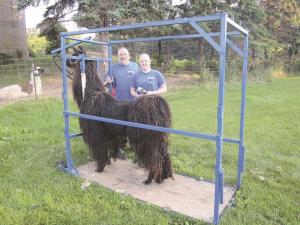Llama Shearing A Good Side Income Job
 ✖  |
“We started raising sheep and llamas about 20 years ago when our kids were in 4-H and FFA. We got pretty good at shearing the show lambs and our own llamas. It grew into a business from there,” says Don Dipprey of Comstock, Wis. “This year I’ll have about 30 to 35 llama-shearing customers in Wisconsin and Minnesota, most of them repeat business.” Dipprey and his daughter Lisa also trim llama toenails to keep their feet healthy.
Dipprey says shearing llamas is different than shearing sheep, where all of the wool is removed from the animals. “We start by blowing the dust and chaff from the animal’s coats. With llamas, there are different cuts that people want depending on how much hair they want to harvest and show requirements.”
Shearing works best with two people, special clippers and a holding crate, Dipprey says. “My daughter Lisa has learned how to shear and trim feet so well that I jokingly say that I am now her right hand man.” The Dippreys use a special shears called a skip tooth plucking blade. It leaves about a half inch of hair on the animal, which protects them against sunburn. “If they were sheared right to the skin they’d fry in the sun and get eaten by flies,” Dipprey says. Shearing is an annual job, done usually from April to June. They also do touch up-shearing for shows during the fair season.
“Shearing has been a great experience for me and my family,” Dipprey says. “I’ve met a lot of wonderful people, and we’ve worked with many types of llamas. I’ve always said I’ve never met a llama owner I didn’t like.” Most of their customers are small farm hobbyists who have 2 to 8 animals.
Dipprey says the market for llama hair isn’t as good as years ago, but the animals still need to be sheared every year to keep cool. Their services cost $27 for a barrel cut with additional charges for other trims. The nudie is $47 because of the extra time required and the wear and tear on blades. Most of their work is done on the owners’ farms, so they often travel several hundred miles a weekend to different farms.
Dipprey says the animals can sometimes be skittish and nervous when he and his daughter show up. “We’re strangers to them, so it’s best if the owners who know and work with them are there to help us. I’ve seldom been kicked in 20 years, but I have been bounced around,” Dipprey says. They shear small yearlings that weigh about 100 lbs. up to older males that weigh more than 400 lbs.
Contact: FARM SHOW Followup, Don Dipprey, Dippreyville Farms, 49 190th Ave., Comstock, Wis. 54826 (ph 715 419-1903; www.dippreyvillefarms.com).

Click here to download page story appeared in.
Click here to read entire issue
Llama Shearing A Good Side Income Job LIVESTOCK Exotic Animals “We started raising sheep and llamas about 20 years ago when our kids were in 4-H and FFA We got pretty good at shearing the show lambs and our own llamas It grew into a business from there ” says Don Dipprey of Comstock Wis “This year I’ll have about 30 to 35 llama-shearing customers in Wisconsin and Minnesota most of them repeat business ” Dipprey and his daughter Lisa also trim llama toenails to keep their feet healthy Dipprey says shearing llamas is different than shearing sheep where all of the wool is removed from the animals “We start by blowing the dust and chaff from the animal’s coats With llamas there are different cuts that people want depending on how much hair they want to harvest and show requirements ” Shearing works best with two people special clippers and a holding crate Dipprey says “My daughter Lisa has learned how to shear and trim feet so well that I jokingly say that I am now her right hand man ” The Dippreys use a special shears called a skip tooth plucking blade It leaves about a half inch of hair on the animal which protects them against sunburn “If they were sheared right to the skin they’d fry in the sun and get eaten by flies ” Dipprey says Shearing is an annual job done usually from April to June They also do touch up-shearing for shows during the fair season “Shearing has been a great experience for me and my family ” Dipprey says “I’ve met a lot of wonderful people and we’ve worked with many types of llamas I’ve always said I’ve never met a llama owner I didn’t like ” Most of their customers are small farm hobbyists who have 2 to 8 animals Dipprey says the market for llama hair isn’t as good as years ago but the animals still need to be sheared every year to keep cool Their services cost $27 for a barrel cut with additional charges for other trims The nudie is $47 because of the extra time required and the wear and tear on blades Most of their work is done on the owners’ farms so they often travel several hundred miles a weekend to different farms Dipprey says the animals can sometimes be skittish and nervous when he and his daughter show up “We’re strangers to them so it’s best if the owners who know and work with them are there to help us I’ve seldom been kicked in 20 years but I have been bounced around ” Dipprey says They shear small yearlings that weigh about 100 lbs up to older males that weigh more than 400 lbs Contact: FARM SHOW Followup Don Dipprey Dippreyville Farms 49 190th Ave Comstock Wis 54826 ph 715 419-1903; www dippreyvillefarms com
To read the rest of this story, download this issue below or click
here to register with your account number.







